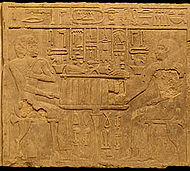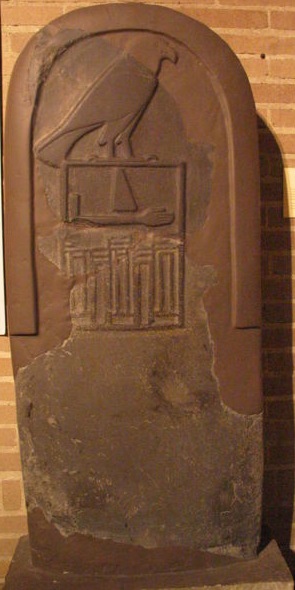
Qa'a was the last king of the First Dynasty of Egypt. He reigned for 33 years at the end of the 30th century BC.
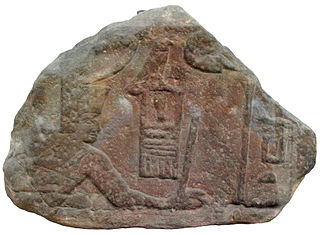
Sanakht is the Horus name of an ancient Egyptian king (pharaoh) of the Third Dynasty during the Old Kingdom. His chronological position is highly uncertain, and it is also unclear under which Hellenized name the ancient historian Manetho could have listed him. Many Egyptologists connect Sanakht with the Ramesside cartouche name Nebka. However, this remains disputed because no further royal title of that king has ever been found; either in contemporary source or later ones. There are two relief fragments depicting Sanakht originally from the Wadi Maghareh on the Sinai Peninsula.

Nynetjer is the Horus name of the third pharaoh of the Second Dynasty of Egypt. The length of his reign is unknown. The Turin Canon suggests an improbable reign of 96 years and Egyptian historian Manetho suggested that Nynetjer's reign lasted 47 years. Egyptologists question both statements as misinterpretations or exaggerations. They generally credit Nynetjer with a reign of either 43 years or 45 years. Their estimation is based on the reconstructions of the well known Palermo Stone inscription reporting the years 7–21, the Cairo Stone inscription reporting the years 36–44. According to different authors, Nynetjer ruled Egypt from c. 2850 BC to 2760 BC or later from c. 2760 BC to 2715 BC.

Huni was an ancient Egyptian king and the last pharaoh of the Third Dynasty of Egypt during the Old Kingdom period. Following the Turin king list, he is commonly credited with a reign of 24 years, ending c. 2613 BC.
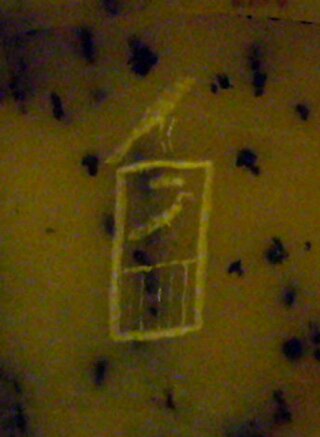
Khaba was a pharaoh of Ancient Egypt, active during the 3rd Dynasty of the Old Kingdom period. The exact time during which Khaba ruled is unknown but may have been around 2670 BC, and almost definitely towards the end of the dynasty.

Weneg, also known as Weneg-Nebty, is the throne name of an early Egyptian king, who ruled during the Second Dynasty. Although his chronological position is clear to Egyptologists, it is unclear for how long King Weneg ruled. It is also unclear as to which of the archaeologically identified Horus-kings corresponds to Weneg.
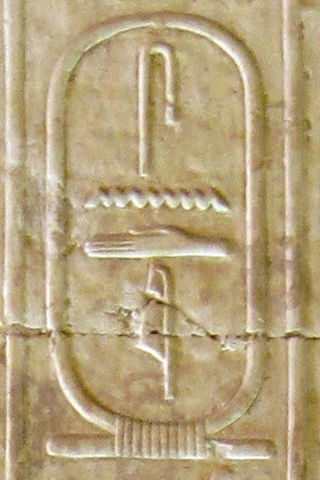
Senedj was an early Egyptian king (pharaoh), who may have ruled during the 2nd Dynasty. His historical standing remains uncertain. His name is included in the kinglists of the Ramesside era, although it is written in different ways: While the Abydos King List imitates the archaic form, the Royal Canon of Turin and the Saqqara King List form the name with the hieroglyphic sign of a plucked goose.
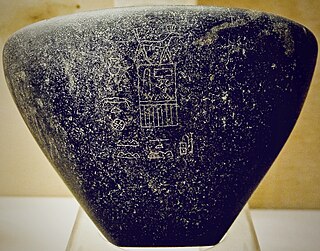
Seth-Peribsen is the serekh name of an early Egyptian monarch (pharaoh), who ruled during the Second Dynasty of Egypt. His chronological position within this dynasty is unknown and it is disputed who ruled both before and after him. The duration of his reign is also unknown.

Sekhemib-Perenma'at, is the Horus name of an early Egyptian king who ruled during the 2nd Dynasty. Similar to his predecessor, successor or co-ruler Seth-Peribsen, Sekhemib is contemporarily well attested in archaeological records, but he does not appear in any posthumous document. The exact length of his reign is unknown and his burial site has yet to be found.

Nebka is the throne name of an ancient Egyptian pharaoh of the Third Dynasty during the Old Kingdom period, in the 27th century BCE. He is thought to be identical with the Hellenized name Νεχέρωχις recorded by the Egyptian priest Manetho of the much later Ptolemaic period.
Thamphthis is the hellenized name of an ancient Egyptian ruler (pharaoh) of the 4th Dynasty in the Old Kingdom, who may have ruled around 2500 BC under the name Djedefptah for between two and nine years. His original Egyptian name is lost, but it may have been Djedefptah or Ptahdjedef according to William C. Hayes. Thamphthis is one of the shadowy rulers of the Old Kingdom, since he is completely unattested in contemporary sources. For this reason, his historical figure is discussed intensely by historians and Egyptologists.

Meresankh IV was a queen of Egypt in the 5th Dynasty. Her name means "she loves life". While some sources consider that her husband is unknown, other sources suggest her husband was Pharaoh Menkauhor Kaiu. It is also possible that Meresankh was the wife of Djedkare Isesi.

Akhethetep was a high dignitary of ancient Egypt who lived during the Fifth Dynasty around 2400 BC. Akhethotep and his son Ptahhotep Tjefi were senior court officials during the rule of Djedkare and of Unas (Wenis), towards the end of the 5th Dynasty. Akhethetep's titles included that of a vizier, making him to the highest official at the royal court, only second to the king. He was also overseer of the treasuries, overseer of the scribes of the king's documents and overseer of the granaries. Akhethetep was the son of Ptahhotep. His father was vizier too.

Neferkasokar was an Ancient Egyptian king (pharaoh) who may have ruled in Egypt during the 2nd Dynasty. Very little is known about him, since no contemporary records about him have been found. Rather his name has been found in later sources.

Wadjenes, also known as Wadjlas, Ougotlas and Tlas, was an early Egyptian king who may have ruled during the 2nd Dynasty. Since the name form "Wadjenes" is not contemporarily attested as the name of a king, but frequently appears in Ramesside kinglists, Egyptologists to this day are trying to connect Wadjenes with contemporary Horus-kings.
Hudjefa is the pseudonym for a 2nd Dynasty pharaoh as reported on the Turin canon, a list of kings written during the reign of Ramses II. Hudjefa is now understood to mean that the name of the king was already missing from the document from which the Turin canon was copied. The length of the reign associated to Hudjefa on the canon is 11 years. Because of the position of Hudjefa on the Turin list, he is sometimes identified with a king Sesochris reported in the Aegyptiaca, a history of Egypt written by the Egyptian priest Manetho in the 3rd century BC. Manetho credits this pharaoh with 48 years of reign. Egyptologists have attempted to relate Hudjefa with archaeologically attested kings of the period, in particular Seth-Peribsen.

Sneferka was an early Egyptian king who may have ruled at the end of the 1st Dynasty. The exact length of his reign is unknown, but thought to have been very short and his chronological position is unclear.
Kay was an Ancient Egyptian official living most likely in the Fifth Dynasty. He is mainly known from his mastaba in Saqqara North. Kay hold a high number of important titles making him the most powerful of his time, only second to the king. His main office was that of a vizier. Beside being vizier, he was also holding many other important titles, such as Overseer of the treasuries, Overseer of Upper Egypt, overseer of the scribes of the king's document, overseer of the six big houses and overseer of all royal works of the king. His mastaba in Saqqara was recorded by Gaston Maspero who assigned to it the number D 19. Kay was bearing 51 titles, making him the vizier with the highest numbers of titles. Kay was the first Egyptian official with the title overseer of the six big houses. The office became one of the most important at the royal court in the later Fifth Dynasty and continued to be so during the subsequent Sixth Dynasty.
Ptahhotep was an ancient Egyptian official of the Fifth Dynasty, most likely under king Djedkare Isesi. His most important office was that of a vizier, making him to the most important official at the royal court, only second to the king. Next to this important office he held further important titles, such as overseer of the treasuries, overseer of the scribes of the king's document, overseer of the six big houses and overseer of all royal works of the king.

Ptahshepses was an ancient Egyptian official at the end of the Fourth and the beginning of the Fifth Dynasty. His main title was that of a great one of the leaders of craftsmen, that in later periods is the main designation of the High Priest of Ptah.
